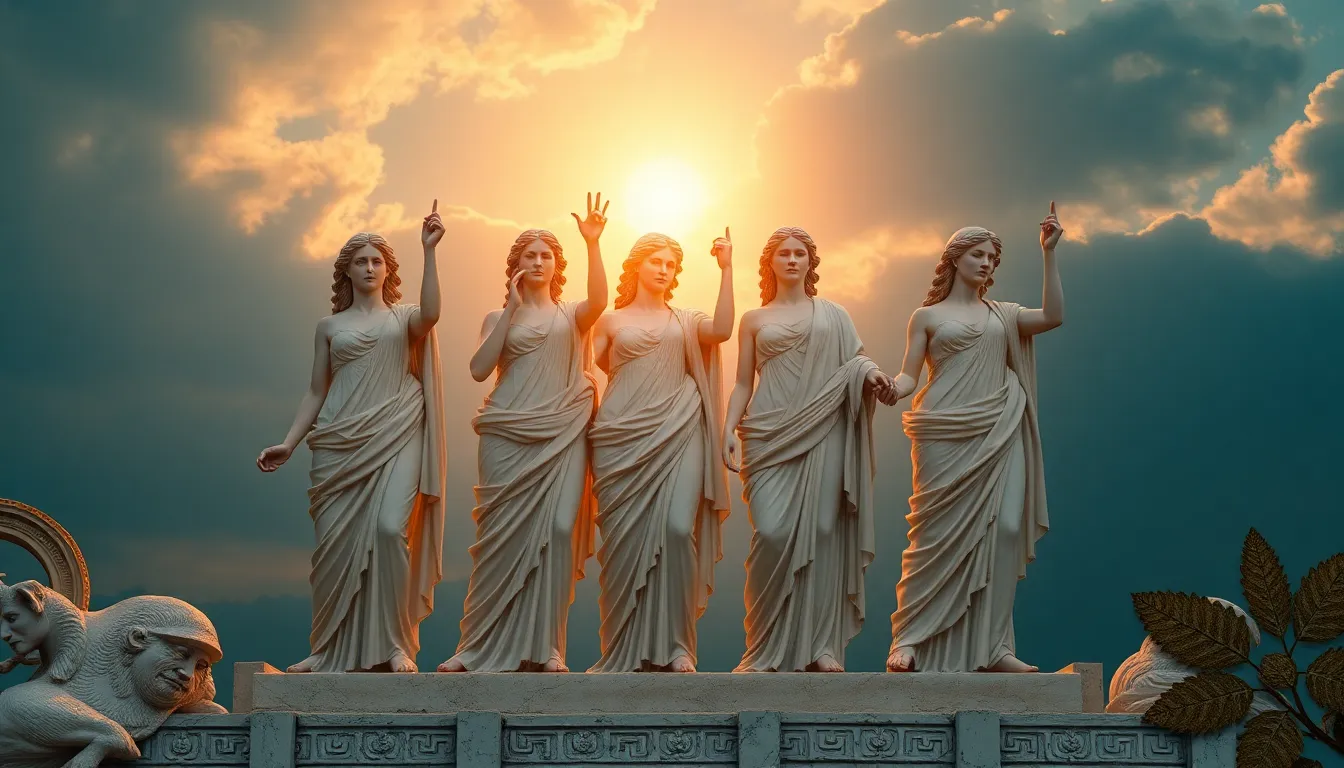The Muses and Their Role in Shaping Cultural Identity
I. Introduction
The Muses, in both historical and contemporary contexts, refer to the nine goddesses of inspiration in Greek mythology, who presided over the arts and sciences. They have been revered as the sources of knowledge and creativity, embodying various forms of artistic expression, including poetry, music, and dance.
Throughout history, the significance of the Muses has transcended mere mythology; they symbolize the essence of artistic endeavor and cultural identity. Their influence can be seen in countless works of art, literature, and philosophy, shaping not only individual creativity but also collective cultural narratives.
This article aims to explore the profound impact of the Muses on cultural identity, examining their historical origins, role across different cultures, and their enduring legacy in the arts.
II. Historical Origins of the Muses
The concept of the Muses dates back to ancient Greece, where they were often depicted as the daughters of Zeus and Mnemosyne, the goddess of memory. Each Muse was associated with a specific domain of the arts and sciences:
- Calliope – Epic poetry
- Clio – History
- Erato – Lyric poetry
- Euterpe – Music
- Melpomene – Tragedy
- Polyhymnia – Sacred poetry
- Terpsichore – Dance
- Thalia – Comedy
- Urania – Astronomy
As the centuries progressed, the notion of the Muses evolved. They began to represent not just divine inspiration but also the cultural and intellectual aspirations of society. Their influence was particularly profound during the Renaissance, when classical texts were rediscovered, leading to a resurgence in the arts and humanities.
The Muses’ impact on classical literature and art is undeniable. They inspired works from Homer’s epic poems to the masterpieces of Renaissance artists, cementing their place as central figures in the history of Western culture.
III. The Muses in Various Cultures
The concept of Muses is not confined to Greek mythology; many cultures have their own versions of inspirational figures. A comparative analysis reveals fascinating similarities and differences:
- Eastern Traditions: In Eastern cultures, figures akin to the Muses often embody wisdom and enlightenment. For instance, in Hindu mythology, the Saraswati goddess is associated with knowledge, music, and arts.
- Western Traditions: The Enlightenment period saw the rise of muses in literature and philosophy, often personifying the pursuit of knowledge and artistic expression.
- Indigenous and Folk Muses: Many indigenous cultures have their own spirits or deities that guide artists and storytellers, playing a crucial role in shaping local identities and cultural practices.
These varied interpretations of the Muses illustrate their universal appeal and the fundamental human need for inspiration across cultures.
IV. The Muses as Symbols of Inspiration
The Muses serve as powerful symbols of inspiration, motivating creativity and innovation among artists, thinkers, and creators. Their influence can be observed in numerous case studies:
- Famous artists like Vincent van Gogh and Pablo Picasso often cited moments of divine inspiration, reflecting the Muse’s role in their creative processes.
- Philosophers such as Socrates and Plato discussed the concept of divine madness, linking inspiration to a connection with the Muses.
The psychological and emotional impact of the Muses is profound. They embody the ideal of creativity, encouraging individuals to explore their artistic potential and express their innermost thoughts and feelings.
V. The Muses in Modern Art and Media
In contemporary literature, film, and music, the representation of Muses has evolved significantly. Today, Muses are often reimagined to reflect modern values and societal changes:
- In literature, characters inspired by Muses often challenge traditional roles, showcasing strong, independent figures who embody empowerment and creativity.
- Films frequently depict Muses as complex characters, influencing protagonists while also navigating their own journeys.
- In music, Muses can symbolize various themes, from romantic inspiration to social justice, reflecting the changing landscape of cultural expression.
Moreover, the rise of digital media has reshaped the image of Muses, allowing for new interpretations and representations that resonate with contemporary audiences.
VI. Cultural Identity and Collective Memory
The Muses play a vital role as custodians of cultural narratives. They help preserve and transmit cultural heritage, contributing to the formation of collective memory:
- Through art and storytelling, Muses help communities remember their history, values, and traditions.
- They highlight the interplay between individual creativity and collective identity, influencing how societies view themselves and their legacies.
The Muses’ contributions to cultural identity formation are evident in various cultural expressions, from festivals to rituals, underscoring their ongoing relevance in a rapidly changing world.
VII. Challenges and Critiques of the Muse Concept
Despite their celebrated status, the concept of the Muse has faced challenges and critiques, particularly regarding gender and power dynamics:
- The portrayal of Muses as passive figures who merely inspire male artists has sparked discussions about the representation of women in the arts.
- Critics argue that this traditional view undermines the active role of women in creative processes and reinforces stereotypes.
- Contemporary debates question the relevance of the Muse in today’s society, particularly in a world that increasingly values individual agency and diverse perspectives.
VIII. Conclusion
The enduring influence of the Muses on cultural identity is a testament to their significance in both historical and contemporary contexts. As sources of inspiration, they continue to shape artistic expression and cultural narratives across the globe.
In a globalized world, the potential for Muses to adapt and evolve remains vast. Recognizing and celebrating the role of Muses in cultural discourse is essential for understanding the complexities of creativity and cultural identity.
Ultimately, the Muses remind us of the power of inspiration and the importance of storytelling in preserving our shared humanity.




